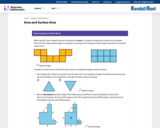
Family facing 6th Grade math unit focusing on area and surface area.
- Subject:
- Geometry
- Mathematics
- Material Type:
- Unit of Study
- Provider:
- Illustrative Mathematics
- Date Added:
- 11/17/2020

Family facing 6th Grade math unit focusing on area and surface area.
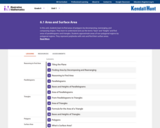
In this unit, students learn to find areas of polygons by decomposing, rearranging, and composing shapes. They learn to understand and use the terms “base” and “height,” and find areas of parallelograms and triangles. Students approximate areas of non-polygonal regions by polygonal regions. They represent polyhedra with nets and find their surface areas.
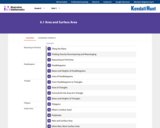
Student facing 6th Grade math unit focusing on area and surface area.

In this activity, students construct their own rocket-powered boat called an "aqua-thruster." These aqua-thrusters will be made from a film canister and will use carbon dioxide gas produced from a chemical reaction between an antacid tablet and water to propel it. Students observe the effect that surface area of this simulated solid rocket fuel has on thrust.
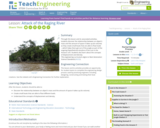
In this lesson, the students will discover the relationship between an object's mass and the amount of space it takes up (its volume). The students will also learn about the concepts of displacement and density.

Students apply their knowledge of surface area and volume to solve some problems for a box company. This lesson contains a detailed lesson plan, video explanations, rubrics, group work guidelines, slides containing problems, and supplemental problems if needed.

What do tin foil, surface area, and rectangular prisms make? A tin foil robot of course! This lesson includes practice problems about surface area, worksheets, a video explanation, and a reflection sheet.

Students solve real-world and mathematical problems involving area, volume and surface area.

Students explore the faces, bases, edges, and vertices of prisms and pyramids to help develop the concepts of volume and surface area.

Practicing math problems to prepare for a geometry assessment involving volume and surface area.
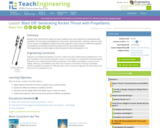
Rockets need a lot of thrust to get into space. In this lesson, students learn how rocket thrust is generated with propellant. The two types of propellants are discussed and relation to their use on rockets is investigated. Students learn why engineers need to know the different properties of propellants.
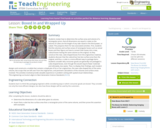
Students find the volume and surface area of a rectangular box (e.g., a cereal box), and then figure out how to convert that box into a new, cubical box having the same volume as the original. As they construct the new, cube-shaped box from the original box material, students discover that the cubical box has less surface area than the original, and thus, a cube is a more efficient way to package things. Students then consider why consumer goods generally aren't packaged in cube-shaped boxes, even though they would require less material to produce and ultimately, less waste to discard. To display their findings, each student designs and constructs a mobile that contains a duplicate of his or her original box, the new cube-shaped box of the same volume, the scraps that are left over from the original box, and pertinent calculations of the volumes and surface areas involved. The activities involved provide valuable experience in problem solving with spatial-visual relationships.
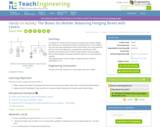
To display the results from the previous activity, each student designs and constructs a mobile that contains a duplicate of his or her original box, the new cube-shaped box of the same volume, the scraps that are left over from the original box, and pertinent calculations of the volumes and surface areas involved. They problem solve and apply their understanding of see-saws and lever systems to create balanced mobiles.
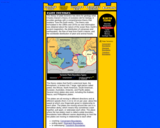
Plate Tectonics provides geology with a comprehensive theory that explains how the Earth works.
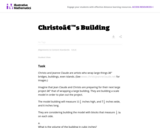
This task is primarily about volume and surface area, although it also gives students an early look at converting between measurements in scale models and the real objects they correspond to.

Looks at how to find the volume and the surface area of a cylinder using the standard geometric formulas. [8:07]
Khan Academy learning modules include a Community space where users can ask questions and seek help from community members. Educators should consult with their Technology administrators to determine the use of Khan Academy learning modules in their classroom. Please review materials from external sites before sharing with students.

In this lesson, students learn that sound is energy and has the ability to do work. Students discover that sound is produced by a vibration and they observe soundwaves and how they travel through mediums. They understand that sound can be absorbed, reflected or transmitted. Through associated activities, videos and a PowerPoint presentation led by the teacher, students further their exploration of sound through discussions in order to build background knowledge.

Use your spatial reasoning skills to calculate the surface area when given a 3D figure. This video focuses on a right rectangular prism and shows you how unit blocks can help you visualize, then calculate the surface area. This video was submitted through the Innovation Math Challenge, a contest open to professional and nonprofessional producers.

Given a problem involving spheres, the student will find the surface area and volume.

In this activity, students investigate the simulated use of solid rocket fuel by using an antacid tablet. Students observe the effect that surface area and temperature has on chemical reactions. Also, students compare the reaction time using two different reactants: water and vinegar. Finally, students report their results using a bar graph.